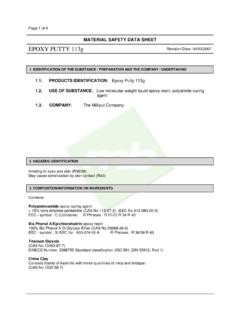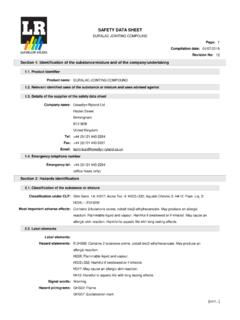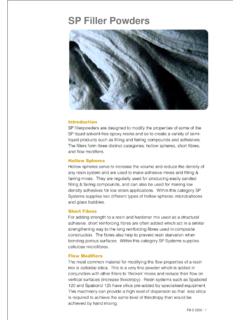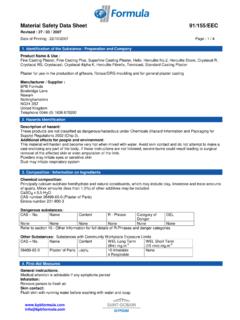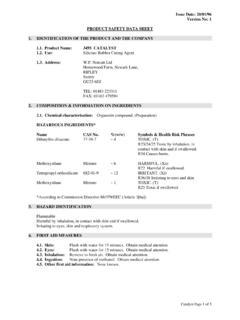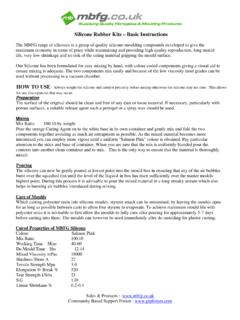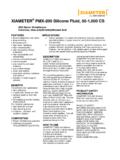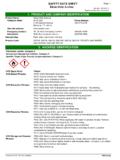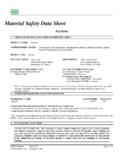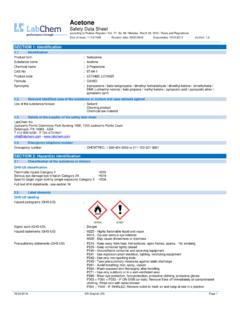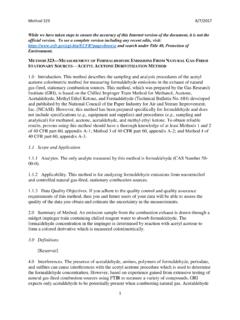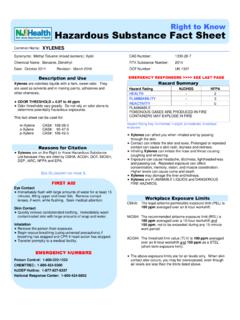Transcription of SAFETY DATA SHEET according to Regulation (EC) …
1 SAFETY data SHEET according to Regulation (EC) No. 1907/2006 acetone Version Print Date 2014/01/23 Revision date / valid from 2014/01/23 MSDS code: MACE001 R51389 1/91 EN Section 1: Identification of the substance/mixture and of the company/undertaking Product identifier Trade name : acetone Substance name : acetone Index-No. : 606-001-00-8 CAS-No. : 67-64-1 EC-No. : 200-662-2 Registration number : 01-2119471330-49-xxxx Relevant identified uses of the substance or mixture and uses advised against Use of the Substance/Mixture : Identified use: See table in front of appendix for a complete overview of identified uses. Uses advised against : At this moment we have not identified any uses advised against Details of the supplier of the SAFETY data SHEET Company : Brenntag UK & Ireland Albion House, Rawdon Park GB LS19 7XX Leeds Yeadon Telephone : +44 (0) 113 3879 200 Telefax : +44 (0) 113 3879 280 E-mail address : Emergency telephone number Emergency telephone number : Emergency only telephone number (open 24 hours): +44 (0) 1865 407333 ( Culham) Section 2.
2 Hazards identification Classification of the substance or mixture Classification according to Regulation (EC) No 1272/2008 Regulation (EC) No 1272/2008 Hazard class Hazard category Target Organs Hazard statements Flammable liquids Category 2 --- H225 acetone R51389 / Version 2/91 EN Serious eye damage/eye irritation Category 2 --- H319 Specific target organ toxicity - single exposure Category 3 --- H336 For the full text of the H-Statements mentioned in this Section, see Section 16. Classification according to EU Directives 67/548/EEC or 1999/45/EC Directive 67/548/EEC or 1999/45/EC Hazard symbol / Category of danger Risk phrases Highly flammable (F) R11 Irritant (Xi) R36 R66 R67 For the full text of the R-phrases mentioned in this Section, see Section 16.
3 Most important adverse effects Human Health : See section 11 for toxicological information. Physical and chemical hazards : See section 9 for physicochemical information. Potential environmental effects : See section 12 for environmental information. Label elements Labelling according to Regulation (EC) No 1272/2008 Hazard symbols : Signal word : Danger Hazard statements : H225 Highly flammable liquid and vapour. H319 Causes serious eye irritation. H336 May cause drowsiness or dizziness. Precautionary statements Prevention : P210 Keep away from heat/sparks/open flames/hot surfaces. - No smoking. P233 Keep container tightly closed. P240 Ground/bond container and receiving equipment.
4 acetone R51389 / Version 3/91 EN P243 Take precautionary measures against static discharge. P280 Wear protective gloves/ protective clothing/ eye protection/ face protection. Response : P303 + P361 + P353 IF ON SKIN (or hair): Remove/ Take off immediately all contaminated clothing. Rinse skin with water/ shower. P304 + P340 IF INHALED: Remove victim to fresh air and keep at rest in a position comfortable for breathing. Storage : P403 + P235 Store in a well-ventilated place. Keep cool. Additional Labelling: EUH066 Repeated exposure may cause skin dryness or cracking. Hazardous components which must be listed on the label: acetone Other hazards For Results of PBT and vPvB assessment see section Section 3: Composition/information on ingredients Substances Hazardous components Amount [%] Classification ( Regulation (EC) No 1272/2008) Classification (67/548/EEC) Hazard class / Hazard category Hazard statements acetone Index-No.
5 : 606-001-00-8 CAS-No. : 67-64-1 EC-No. : 200-662-2 Registration : 01-2119471330-49-xxxx C&L-No. : 02-2119752542-40-0000 <= 100 Flam. Eye STOT SE3 H225 H319 H336 Highly flammable; F; R11 Irritant; Xi; R36 R66 R67 For the full text of the R-phrases mentioned in this Section, see Section 16. For the full text of the H-Statements mentioned in this Section, see Section 16. Section 4: First aid measures Description of first aid measures General advice : Remove from exposure, lie down. Take off all contaminated acetone R51389 / Version 4/91 EN clothing immediately. If inhaled : Remove to fresh air. If breathing is irregular or stopped, administer artificial respiration.
6 If unconscious place in recovery position and seek medical advice. In case of skin contact : Wash off immediately with soap and plenty of water. Call a physician if irritation persists. In case of eye contact : Consult an eye specialist immediately. Rinse immediately with plenty of water, also under the eyelids, for at least 10 minutes. If swallowed : Clean mouth with water and drink afterwards plenty of water. Never give anything by mouth to an unconscious person. If swallowed, do not induce vomiting - seek medical advice. If a person vomits when lying on his back, place him in the recovery position. Most important symptoms and effects, both acute and delayed Symptoms : No information available.
7 Effects : No information available. Indication of any immediate medical attention and special treatment needed Treatment : Treat further information available. Section 5: Firefighting measures Extinguishing media Suitable extinguishing media : Use water spray, alcohol-resistant foam, dry chemical or carbon dioxide. Unsuitable extinguishing media : High volume water jet Special hazards arising from the substance or mixture Specific hazards during firefighting : Vapours are heavier than air and may spread along floors. Vapours may form explosive mixtures with air. Flash back possible over considerable distance. In case of fire hazardous decomposition products may be produced such as: Carbon monoxide, Carbon dioxide (CO2) Advice for firefighters Special protective equipment for firefighters : In the event of fire, wear self-contained breathing appropriate body protection (full protective suit) Further information : Cool closed containers exposed to fire with water will cause a pressure rise - with risk of contaminated fire extinguishing water separately.
8 This must not be discharged into drains. acetone R51389 / Version 5/91 EN Section 6: Accidental release measures Personal precautions, protective equipment and emergency procedures Personal precautions : Use personal protective equipment. Keep away unprotected persons. Provide adequate ventilation. Keep away from heat and sources of ignition. Avoid contact with skin and eyes. Do not breathe vapours or spray mist. For personal protection see section 8. Environmental precautions Environmental precautions : Do not flush into surface water or sanitary sewer system. Avoid subsoil penetration. If the product contaminates rivers and lakes or drains inform respective authorities.
9 Methods and materials for containment and cleaning up Methods and materials for containment and cleaning up : Contain spillage, and then collect with non-combustible absorbent material, ( sand, earth, diatomaceous earth, vermiculite) and place in container for disposal according to local / national regulations (see section 13). Further information : Treat recovered material as described in the section "Disposal considerations". Reference to other sections For personal protection see section 8. Section 7: Handling and storage Precautions for safe handling Advice on safe handling : Keep container tightly closed. Ensure adequate ventilation. Use personal protective equipment.
10 Avoid contact with the skin and the eyes. Do not breathe vapours or spray mist. Emergency eye wash fountains and emergency showers should be available in the immediate vicinity. Hygiene measures : Keep away from food, drink and animal feedingstuffs. Smoking, eating and drinking should be prohibited in the application area. Wash hands before breaks and at the end of workday. Take off all contaminated clothing immediately. Avoid contact with the skin and the eyes. Do not breathe vapours or spray mist. Conditions for safe storage, including any incompatibilities Requirements for storage areas and containers : Keep in an area equipped with solvent resistant flooring. Suitable materials for containers: Mild steel; Stainless steel; polyethylene acetone R51389 / Version 6/91 EN Advice on protection against fire and explosion : Combustible liquid; Keep away from sources of ignition - No smoking.
